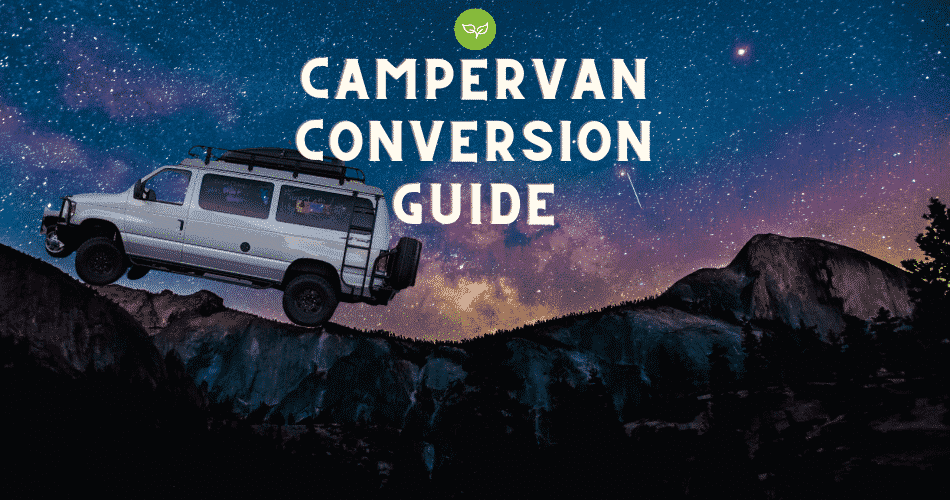If you are looking to learn how to transform your van into the ultimate cross country adventure machine–from someone who has lived it–you’ve come to the right spot.
I traveled across the U.S. and visited 48 of the 50 U.S. states, and this experience was easily the greatest year of my life.
It brings me a lot of joy to share my learnings and knowledge with other aspiring #vanlifers.
In this comprehensive guide, I lay out everything you need to know about campervan conversions–and just a warning, it’s a monster article because a lot was covered, including:
- What your van options are and what to look for purchasing (I include some of my own hacks that can help you save some money)
- Determining your layout and what your dream van looks like
- Setting up your insulation, flooring options, toilets, sinks, showers, solar systems, cooking, and way more
[toc]
What is VanLife?
If you’re reading this article, I’m guessing you’ve got a pretty good idea of what Vanlife and Vanlifers are all about, so I’ll keep this brief. Vanlife involves taking a van, small RV, truck, or automobile camper and turning it into your permanent home.
Instead of going out for weekend adventures, you live full-time in a converted vehicle. Some people do it out of necessity, but an increasing number of folks are beginning to prioritize the flexibility, cost savings, and general freedom that comes from having no permanent address, rent, or similar obligations that tie you down.
What Makes You Want to Try Vanlife?
I loved the Vanlife, but I’ll be completely upfront that it isn’t for everyone. If you’re someone who thrives on a routine, AC, or who likes taking a 6:45 hot shower every morning, you probably won’t succeed in a van. Here are some reasons I feel can make living remotely in a van or similar vehicle worth it.
Travel and Adventure
Always wanted to see America? Or South America? There’s no better way to visit 49 out of 50 states and everywhere in between than in a van. Vans offer enough space to bring the essential comforts with you while still being small enough, stealthy enough, and affordable enough to allow you to travel just about anywhere.
I took my van up twisty Rocky Mountain roads, across the Great Plains, and even out to beautiful Pacific beaches. You can visit just about every part of this beautiful country in a van and have an absolute blast doing it.
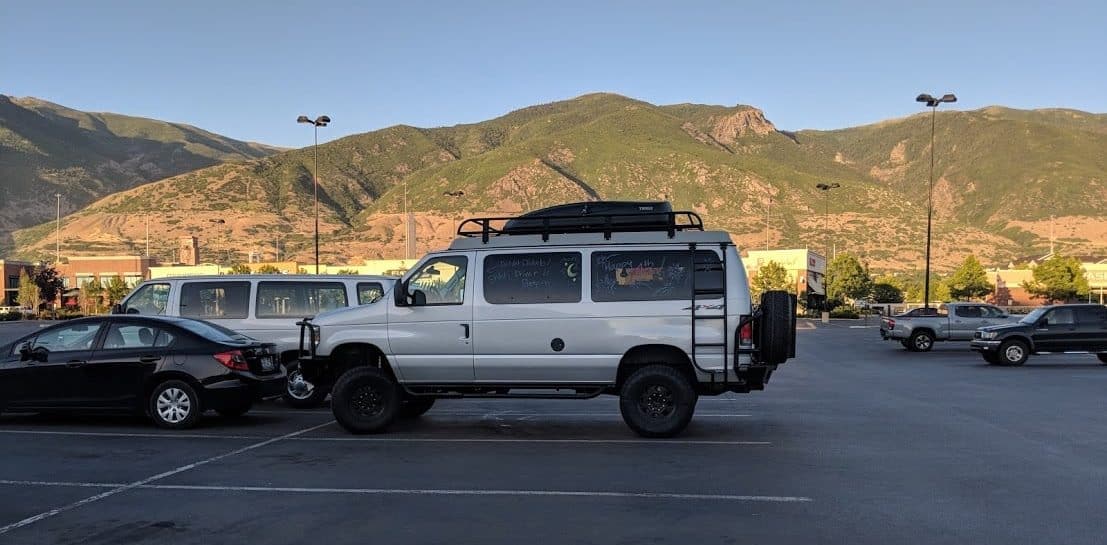
Living Big on Less/Saving Money
While Vanlife can be a great way to save on rent, utilities, and other housing-related expenses, it depends on how you do it whether or not it will be a great cost-saving measure. I’m sure you’ve seen what I like to call ‘Insta’ Vans.’
A glammed up, top-of-the-line professional Sprinter van conversion or similar is going to cost a pretty penny, with the van itself costing upwards of $25K and the conversion often putting you above $50K all in.
If that’s the kind of budget you’re looking at, great! If saving money is the name of the game, you can honestly put a camping pad and sleeping bag in the back of your current car and call it a day. Or if you want the middle ground between camping bad and ‘insta’ van, you can get a roof top tent. I had one during my travels across the U.S. and can’t recommend them enough. I wrote a review about them here.

Minimizing and ‘Getting Away From it All’
Let’s face it, the past year has given all of us a real wake-up call on the fragility of things. We’ve seen friends and family (or even ourselves) lose jobs, homes, life savings, and even, sadly, lives, as the entire world has been upended and permanently altered by COVID-19.
Many people I’ve spoken with have expressed the desire to focus on what really matters and stop letting the ‘things’ they thought they needed run their lives. Minimalism has been popular for years now, but like many big changes, it takes big events to put things into perspective.
Van life is a really good option if you want to see just how minimal you can get, as you’ll only have room for the essential things in your life.
Intro to Van Types and Options
When picking out the best van for your living situation, you won’t be short on choices. There are tons of different types, models, and styles of van to choose from. A few of the most popular options are:
- Conversion Vans
- Cargo Vans
- Class B Motor Homes (‘Camper’ Vans)
- Euro vans (Sprinter, Transit, Promaster, etc)
- Classic ‘Hippie’ vans (VW Vanagon, VW Kombi Bus, Westfalias)
- ‘Scooby Doo’ vans (70s/80s Dodge, Ford, and Chevy models ala Econolines)
- Skoolies (School bus/Short bus conversions)
- Overlanding vehicles (Expedition rated 4WD vans, camper trucks, etc)
- Your current vehicle (Pretty much any car, truck, or SUV can become a comfortable living space with a few tweaks)
I’ll dig into this much deeper in a later article. For now, the essential points to remember are that newer vans are generally nicer, larger, and offer better gas mileage/lower operating costs but run significantly higher in purchase price.

Conversion and cargo vans are going to be a lot cheaper, but they won’t have the same volume, are usually older/require more maintenance, and generally aren’t as ‘nice.’
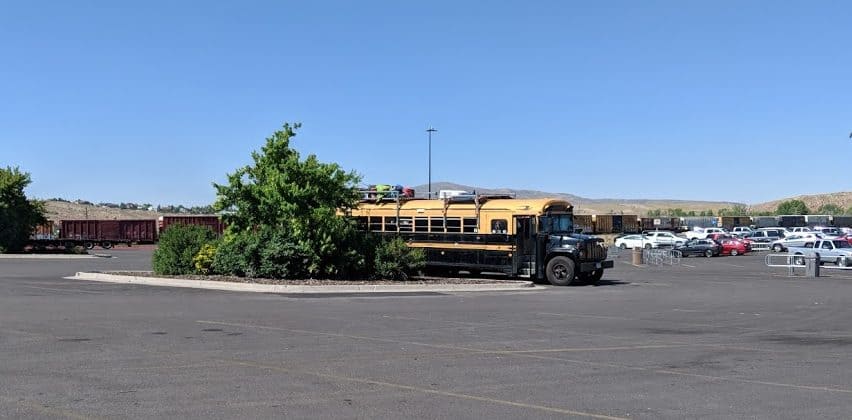
VW vans are a category all their own, as their popularity combines the high upfront cost of a newer Sprinter style van with some of the highest operating costs, repair demands, and general headaches of any van.
They’re iconic, to be sure, but many are also going on 50+ years old at this point, and a good chunk are running on duct tape and prayers.
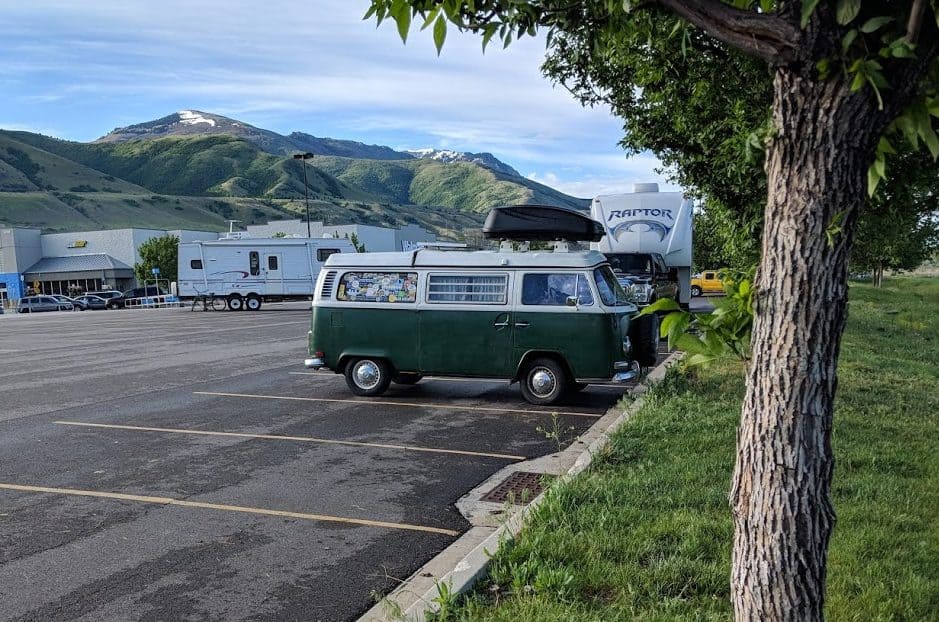
Standard vs. High Top
If you’ve been trawling Instagram for sweet #Vanlife pics, you’ve undoubtedly seen the incredible headroom in new Sprinters and similar vans.
They’re great for comfort and usable interior space, but they aren’t without their downsides.
The biggest are cost, drivability/parkability, stealth, and oh yeah, did I mention cost?
Even used, beat-up high tops cost a pretty penny and can dig deep into your build budget before you’ve made the first modification to bare aluminum walls. The added height is excellent on the inside but seriously restricts where you can drive and park your van.
Weigh the benefit of being able to stand fully in your van vs. the cost in cash, stealth, and movement.
How to Buy a Van
While bright, shiny new vans are incredibly tempting, most people seriously considering van life aren’t looking to drop a small fortune on a new van. That leaves used camper, cargo, vintage, and conversion vans as the best option.
I recommend you think about exactly what you need to be happy in a van. Space, configuration, height, style, reliability, etc, are good places to start and can help you eliminate some models right off the bat.
If you have the chance try and rent a couple of models of campervan to check them out. I guarantee you’ll find out something about what you need that you didn’t know before you do.
If you’ve ever bought a used car before, the process is very similar. You want to get the mechanicals checked out as best as you possibly can, especially with older or vintage vans. I highly recommend you take them to a mechanic and pay for a full vehicle inspection if possible. Not all sellers are going to be cool with this, though, so use your best judgment.
When I searched for vans to convert, I found one that was ‘perfect’……until the mechanic revealed that the transmission was on its last legs. That would have been a costly mistake if I hadn’t had it checked out.
How to Convert a Van for #Vanlife
I’m going to be clear here: I’m not a professional van outfitter, a mechanic, or even a guy who plays one on TV. I’ve got a lot of personal experience from converting my van and my year living in it, and I did a massive amount of research while figuring out what I wanted to do in building out my van.
There are tons of different ways to convert a van and hundreds of different configurations and styles you can follow to do so. The information below covers the essential questions that everyone building out a camper van will have to answer, advice on the planning and construction process, and several excellent product options for different aspects of the build.
Figuring Out Your Layout
The layout of a van dictates everything about how it can be used. There are several key questions to ask yourself before making any modifications. Think about:
- Who will be riding/living in the van?
- How much storage space do you need?
- Do you need a workspace (desk/chair/recording spot/etc)?
- Do you want a toilet or shower?
- Will you be cooking in your van?
- What kind of gear do you need to stow (bikes, boards, hammocks, etc)?
- Do you want seating (other than the bed) in the ‘living space’ of your van?
Answering those questions will give you a rough draft of what kind of amenities you need to build in and help you figure out the most efficient way to get it done. Your van shell’s physical size, shape, and configuration will play a major role in determining your options.

A great way to figure out what you need is to check out what others have already done. Instagram, Pinterest, and Youtube are full to bursting with fantastic van builds ranging from urban stealth campers to full-up off-roading expedition vehicles.
Camper Van Insulation and Barriers
Insulation in a van is functionally the same as a traditional home or tiny house, just at an even smaller size. There are several different options with some of the most popular, including:
- Spray Foam
- Loose-fill or Insulation Batts
- Rigid Foam Boards
- Thinsulate
- Reflectix
- Wool
I’ve covered tiny house insulation in-depth, and camper van insulation is very similar. One thing to keep in mind is that it isn’t always necessary or even a good idea to insulate your van.
This is especially true if you plan to live in warmer climates where cooling down rapidly after sunset is more important than retaining heat in cold conditions.
Moisture and Condensation are serious threats in any camper, but especially so in a van. It’s vital to try and seal up any cracks, gaps, or holes in the body of your van to keep rain and other water out. However, I don’t recommend installing a proper moisture barrier.
Why?
Basically every activity you take inside the van, from breathing to cooking, will produce water vapor that becomes condensation. Rather than keeping outside moisture out, a moisture barrier serves mainly to trap inside moisture (condensation) in.
Sound barriers are another consideration, but not what I’d call a must-have. Some people I’ve met in the van community swear by them, but many others say they never noticed a difference. A sound barrier goes on the physical metal of your van and helps reduce road noise while driving.
Camper Van Walls and Ceilings
Walls and ceilings are one of the ways you can make a van feel like a real home. There are plenty of different options, including luan paneling, shiplap, tongue and groove, etc.
Your budget and DIY skill dictate your choice of material. Some of the easiest and lowest maintenance options include durable plastic sheeting or even aluminum composite panels (ACP).
Make sure you thoroughly research how to cut and fit the material you choose.
Camper Van Flooring Options
Flooring a van today is much, much easier than it was even just a few years ago. You can go with something like laminate flooring, but I highly recommend choosing fully synthetic vinyl flooring.
Why?
Water.
Modern vinyl flooring looks extremely elegant, is highly durable, easy to clean, and is 100% resistant against water damage, swelling, and problems that come from being on the road. As a bonus, it’s one of the easiest flooring materials to install, with many requiring only a click-lock for individual pieces and adhesive to secure edge pieces.

Check out my full breakdown on tiny house flooring for a no-nonsense explanation on picking out flooring in a vehicle dwelling.
The Million Dollar Question: Where do You Go to the Bathroom in Vanlife?
Whenever anyone asks me about my time living in a van, without fail, the first question is always “Where do you go to the bathroom”? Most expect me to bring up a composting toilet, some kind of cartridge toilet, or something along the lines of a bucket camping toilet.
Truthfully, though? Bathrooms are everywhere.
99.99% of the time, there’s going to be a free public restroom available to use.
If you’re stealth camping in a city, I guarantee you that there’s a Walmart, a grocery store, a gas station, or a public library that’s got plenty of nice, clean toilets available for anyone to use.
Out in the wilds?
Most campsites have toilets, as do a vast chunk of semi-developed National Forest, BLM, and other free or low-cost camping areas. I can count on one hand the number of times I was somewhere with truly no access to a bathroom.
That being said, some people prefer the convenience/comfort of having their own bathroom in their campervan. There are thankfully plenty of great options available.
Vanlife Bathroom Options
The Pee Bottle: This is exactly as it sounds, an opaque bottle for you to pee in then empty into a toilet later. It’s easier for guys, but there are plenty of great options for ladies, such as the popular GoGirl or SheWee female urination devices.
Composting Toilets: One of the most popular options for tiny dwellers, I don’t generally recommend a composting toilet for Vanlife. They’re highly effective and can go weeks between being emptied, but they also take up a lot of space and have to be properly vented and managed to work right.

The Bucket: The classic bucket toilet ala the Luggable Loo is one of the easiest and most cost-effective ways to add a toilet to your van. They’re cheap, effective, and work great as a short-term solution when out boondocking or as an emergency back up—pair one with something like a GigaTent for more comfort and privacy. Check out ultra-compact folding style toilets for similar usability but in a much smaller stored footprint.

Cassette Toilets: Basically an RV toilet system in miniature, cassette toilets are compact, easy to use, and offer a good option if you really want a more traditional bathroom experience. They use two tanks, blue water and black water, that allow you to manually flush after going to the bathroom and then empty out the tank later. They do generally contain chemicals that help reduce odors and break down waste, so if that’s something you care about keep it in mind.
Vanlife Water, Sinks, and Showers
Water is one of the most important parts of building out your van. You need it to drink, to cook with, and for hygiene. You can go very low tech with just a water storage tank plus a plastic container to use as a sink or add in things all the way up to full blue and black water storage with a permanently mounted sink and shower.
Storing Water in a Van
A lot of people get intimidated by the thought of installing and managing a van water system. Depending on your needs, budget, and desires it can be either one of the most complicated parts of Vanlife or one of the cheapest and simplest.
I went with a simple 7-gallon water storage jug + spigot that fit underneath my bed and could be used to fill all kinds of containers. It was cheap, it was easy to pull out when I needed to fill it, and it gave me three to five days’ worth of water at a go.
You may choose to go with a fully plumbed system including blue and gray water tanks plus a sink/shower, but to be honest that’s usually overkill in a van.
Recommended water storage:
Finding Water in a Van
You’d be shocked how many places have either free or highly affordable access to fresh drinking water. In my experience, virtually every grocery store above the size of a bodega/quick stop will have one of those water dispenser machines, usually for under $.50 a gallon. Other great sources of water include:
- Parks, Beaches, and Picnic Areas
- National and State Park Visitor Areas
- Campgrounds and RV Parks
- Dump Stations
- Gas Stations/Truck Stops
Camper Van Sinks
Sinks are another touchy subject in a camper van. Some folks go for permanently installed sinks similar to those used in traditional RVs, while others opt for things such as hand pumps, foot pumps, or even the classic water bottle and basin.
Permanently installed sinks equal basic plumbing and permanent mounting. You need to either wire in a DC pump or use a foot/hand pump. All that gear takes up precious space, so unless you seriously want a sink, I recommend you stick with a more modular option like a portable basin and squeeze bottle.
Recommended Vanlife Sink Stuff:
Camper Van Showers
Like many things in living the Vanlife, keeping clean on the road requires a bit more forethought and planning than in a traditional home. I’m going to say something a little controversial here:
You probably don’t need a dedicated shower in your campervan.
Most people aren’t getting covered in road dust and grime every single day. You can go a lot longer than you think between showers while still feeling and smelling great, especially if you incorporate some basic hygiene tactics like shower wipes, sink/bottle and cloth, and dry shampoo.
When you feel it’s time to shower off, there are plenty of publicly accessible showers just about anywhere. Some of the best places to find a shower are:
Gyms – Small gyms cost next to nothing ($5-$20 monthly) to join and have huge networks of locations. Planet Fitness (my personal choice) is the gold standard for Vanlife, but there are plenty of others.
Campgrounds – Any developed campground is going to have shower facilities. If you’re really feeling the need to clean off you can get a site for $10-$20 and enjoy the facilities.
Truck Stops – Truck stops are everywhere along the highways and offer pay showers for a very reasonable ($8-$15) cost.
Hotels – While definitely a more expensive option, it can be nice to stay somewhere with AC, a soft bed, and a hot shower/bath now and then. Bonus points if they have a delicious complimentary breakfast.
Some great items for keeping clean on the road:
- Shower wipes
- Dry shampoo
- Gravity showers/camping showers
- DC powered shower head
- Portable hot water heater
Van Temperature Control
Keeping a comfortable temperature in a van isn’t the same as in a home with central HVAC. You won’t have the fine-tuned control of a thermostat, but by taking a few simple steps, you can achieve a remarkable degree of comfort no matter how warm or cold it gets.
Staying Cool in a Van
Staying cool and comfortable in your van is all about controlling the buildup of heat. In a van setting, AC isn’t a viable option. Power and space requirements both make it all but impossible to pull off.
What you can and definitely should do is invest in a high-quality vent fan. They double as an exhaust vent for cooking/condensation and are an absolute lifesaver in creating airflow within your van.

An essential tool to keep the heat out of your van are Reflectix panels in the windows and windshield. They reflect the heat of the sun and help prevent it from warming you up too much.
Other great ways to stay cool include going for a refreshing swim, hitting up your gym for a cool shower, the ‘Egyptian Method’ (damp towel/sheet to sleep under), and spending the sunny parts of the day in public spaces with AC.
One great thing about living in a van is that you can solve hot summer problems by driving north or heading for a higher elevation location.
Gear to stay cool in a hot van:
- MaxxAir MaxxFan Deluxe (Don’t be fooled by Fantastic Fans, MaxxAir is the way to go)
- Reflectix panels (cut to size for your windows)
Staying Warm in a Van
As I mentioned in the above insulation bit, I’m not a big believer in adding heavy insulation to a van. In most cases, the benefits are outweighed by the costs and generally aren’t even needed to stay comfortable and safe.
Have you ever been in a car that’s sitting in the sun?
Even if it’s pretty cold outside, it rapidly starts to warm up on the inside as the sun’s heat comes through the van’s windows and skin. During daylight hours, that plus basic warm clothes can be enough to keep your vehicle at a comfortable temperature so long as it isn’t truly frigid outside.
You can get a small heater system, though I don’t recommend a permanent diesel heater as they’re generally unneeded and overly complicated. A small propane or kerosene unit gets the job done if you want to get a bit warmer.
Honestly though?
Thick blankets, warm sleep clothes, and basic common sense will get you through all but truly arctic conditions. I slept comfortably in my van down to 10℉ without a heater and with minimal insulation.
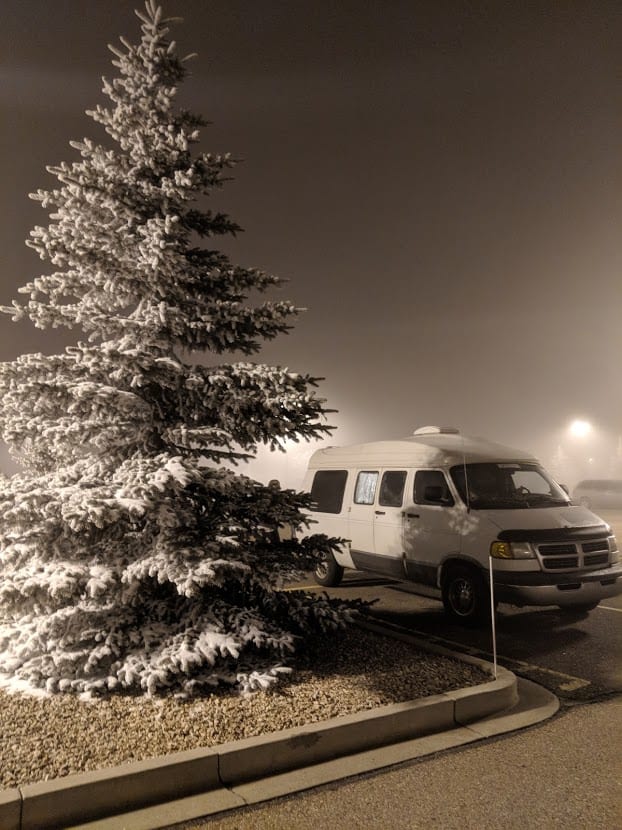
Still cold?
One of the best things about living in a van is that you can pick up and move when you get tired of somewhere. Head for southern climates or lower elevation if you find the local winter too chilly.
Things I found really useful for staying warm and cozy:
Vanlife Food
Storing and cooking food is a lot easier in a van than most people think. Here are a few good options to help you get started.
Cooking in a Camper Van
If you’ve ever been car camping before, the cooking method for Vanlife will be highly familiar. Propane, butane, or small ultralight isobutane stoves are the name of the game.

You can cook up anything that will sizzle in a skillet on one of those and easily make coffee or other hot drinks with a classic kettle.
Recommended Vanlife kitchen essentials:
Storing Food in a Van
With a properly sized solar power system for your campervan, it’s quite possible to have a DC-powered refrigerator in a campervan. I’ve covered DC and Thermoelectric coolers before, with some great detailed information there to help you make your choice. They start in price around the low $100s of dollars and can reach over $1,000 for large or high-end models.
If you don’t want to go to the trouble of wiring and powering a 12v DC fridge, you can also go old school with it and keep your cold goods in a well-insulated cooler. YETI, RTIC, Coleman, and even stores like Walmart all make high-quality rotomolded coolers that can keep your food chilled for days without issue.
If you’re willing to pick up ice regularly, it’s a great and low-cost option.
Camper Van Lighting Options
Lighting a camper van at night is pretty straightforward. You can choose from permanent fixtures or portable options.
Camping Lights, Lanterns, Flashlights
One option for lighting your campervan is to use small camping light strings, portable lanterns, flashlights, and headlights for when you’re completing tasks. The benefits are that it requires no wiring or other complicated steps, but it does lack some of the ‘homey’ feel of wired lights.
Wired LED Lights
Wiring in recessed LED lights, LED strip lights, or even using something like small stick-on LED lights is a way to put a more permanent lighting option in your van. They require more installation, but they’re great for making your van feel more like a traditional home.

Vanlife Solar Power Systems and Battery Banks
Important Disclaimer: I am not an electrician or electrically trained. Working with electricity is inherently risky and requires a strong knowledge of multiple important safety topics. DO NOT confidently follow wiring diagrams you find online without first triple checking them against electrical concepts. The information below covers the basic components of a working solar system as well as how they work together, but shouldn’t be used as an installation guide. If you hire a professional to do any part of your van build, I recommend you do so for the electrical system.
Not sure you want to build your own DIY solar power system? A solar generator gives you a plug-and-play way to power your van without having to worry about wiring. It’s more expensive than building a system yourself, but much, much easier to do. Check out my review on the best solar generator systems to learn more.
There are four key components in a modern off-grid solar power system. These are:
- Solar panels
- Charge controller
- Battery bank
- Inverter
Before putting together your solar power system, you need to know how much power you need. My article on calculating tiny house solar needs goes through the process. The principle is the same for a camper van. Once you know how much power you need, you’re ready to compare different system components.
Check out my full off-grid power system article to learn more about the components and installation process.
Solar Panels
When choosing the right type of solar panel for your van, you have to choose the type and output. There are both monocrystalline and polycrystalline panels, as well as flexible vs. rigid panels.
Polycrystalline panels are less efficient but generally a little cheaper, while flexible panels are thinner, lighter, and more portable than rigid panels but also less durable.
For a camper van solar system, I recommend you go with monocrystalline flexible panels. They’re easy to work with, provide excellent efficiency, and can be installed either permanently with mounting tape or used as portable panels that stow away when you move.

Here’s my pick for the top ten best flexible solar panels on the market today.
Charge Controllers
Once you’ve got your panels, you need a charge controller to manage your batteries’ flow of power properly. There are both PWM and MPPT charge controllers on the market, but I highly recommend you go with an MPPT charge controller for a campervan.
They’re a bit more expensive on average, but they also offer 10-40% higher charging efficiency than a PWM charge controller.
Check out my full charge controller review to learn more about the pros and cons of MPPT charge controllers and find out what the best on the market today are.
Solar Power Batteries
Prepare yourself here, as batteries will be by far the most significant expense when putting together your camper van solar power system. There are several different varieties available for use with solar power systems, but for a campervan you should only consider two: AGM and lithium.
They offer the best mix of performance, low maintenance, and lifecycle. They’re also the easiest to install and work with.
Inverters
The inverter takes the DC power stored in your battery bank and changes it into AC power, such as that found in a traditional home. You can get away without an inverter if you only wish to run DC appliances and charge a few small electronics, but most vanlifers choose to install an inverter.
Inverters are rated in watts, with higher wattage inverters able to handle higher power draws.
Here are a few I recommend:
Solar Alternative: Alternator Charging
If you plan to move around frequently in your van you may be able to charge your battery bank entirely from your alternator without using solar. To do so you’ll have to wire your battery bank to your vehicle’s alternator using a battery isolator.
An isolator allows your batteries to charge from the alternator while your vehicle is running without draining your ignition battery while parked.
Hitting the Road
Once you’ve bought your van, built out the setup, and filled it with essential gear, you’re ready for the very best part: Hitting the Road. There are few things as enjoyable as taking the van you built with your own two hands out at the start of an adventure.

